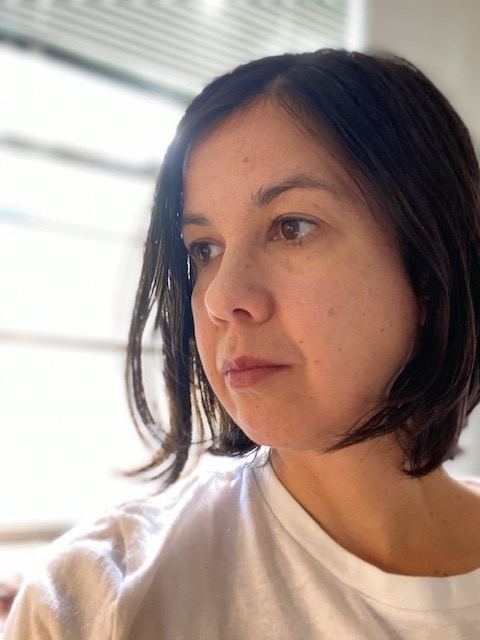A Pine Struggles for Life on The Mountain Top
Maybe not a struggle say but a need to bend nothing to
do with desire this has nothing to do with the shape of
swooning or weeping or agony the branches do not in
my opinion despair they reach with their own belonging
stripped bare-bone plying on the side where the wind is
merciless some art the way it’s shaped is truly merciless
we are talking about something outside of tools outside
of hedge trimmers and chords A will independent a
shaping but what is this shaping for? No the green pine
is perfectly thriving its living part upswept its barren part
protected high up a cost must come with this elevation
not struggle not yearning just time and element

Beaver Dam and Mountain Reflection
Rocky Mountain National Park
When the mountains are reflected they are reflected in a
dim blue. The strange fact is the mountains are not the
mirror opposite but the reflection of a memory of
another range. See here, if you compare the peaks they
are not exact—there appear to be small adjustments.
Every reflection is suspicious because we’ve seen it
lie—that’s what’s dazzling, that’s what holds our
interest, which is more beautiful the water’s rendering or
the sky’s? And how can you begin to tell the difference?
Beavers have left a confusion of logs on the sand—long
slender teeth, fleshless finger bones, they are, or could
be, the beginnings of a house.

Hot Springs of Yellowstone
Fires small, fires e verywhere on the yellow hill. Pockets
of green. Even the blue sky fails at cooling what is notmanmade, what is not a disaster. Always the temptation
to see a matchstick house set in a vacant stretch between
lonely trees and the fire’s scribbled-out meaning, a
child’s curlicue of smoke drawn, rising through a
chimney. The earth reclaims all its chimneys now. I, I. Between the springs, there are
have to cross myself out
no connecting verbs or prepositions. Smoke does not
need sentences to describe—the signals wedged between
yellow and stone, hot and spring, green and the yellow
land scrubbed of it.

Yellowstone Canyon
A Young River
A young river has not lost its name, it rises in the black
waves—disappears white silky ribbons. The crashing
happens up front, moves down into the interior, the
green slopes towards it—the river is both held up by the
canyon and charging into its rock. A rushing sound.
When water froths, it’s smooth and dangerous, the color
is a light emerald. The sun hits the smoothness at a slant,
not a hill because there’s nothing to roll up from. In
greener areas, stands of trees, belonging fiercely, rooted
fiercely placed like a fingerprint in the corner. I said I
would not mention human life—this is not about human
life, this is about a young river with a long name.

Yellowstone National Park
Emerald Pool
Emerald green is a color that laps its smoothness around
the banks, where sand turns hot orange and maybe
there’s ice, lumpy, wet, and round pockets of trees sunk
in spots, brown, growing greener towards the hill’s
slope. The exact texture of water burns and is cool, the
deposit doesn’t match, it has too much electricity. It’s
hard to get a sense of how and why it arrived. Nothing in
the landscape itself asks that question. There is a brief
patch of emerald grass direct in the sun. The water is less
odd when you remember green isn’t uniform, the shape
of the pour, the unmatched water behind it, seems to
arrive out of nowhere. Maybe that’s why there’s a sign
nailed, telling us we’ve arrived at something new. Trees
break from the surface, ice clings to what breaks from
the emerald water.

Photo credits:
Moldenke Lantern Slide Collection, University of Texas Plant Resources Center. Austin, Texas.
Slide: A Pine Struggles for Life on A Mountain Top
[unlabeled], A Pine Struggles for Life on A Mountain Top, [undated], Moldenke Lantern Slide Collection, University of Texas Plant Resources Center. Austin, Texas.
Slide: Beaver Dam and Mountain Reflection Rocky Mt. National Park
Scott, John D. and Van Altena, Edward, Beaver Dam & Mountain Reflection Rocky Mt. National Park, [undated], Moldenke Lantern Slide Collection, University of Texas Plant Resources Center. Austin, Texas.
Slide: The Hot Springs of the Yellow-Stone
Van Altena, Edward, The Hot Springs of the Yellow-Stone, [undated], Moldenke Lantern Slide Collection, University of Texas Plant Resources Center. Austin, Texas.
Slide: Yellowstone Canyon
[unlabeled], Yellowstone Canyon A young river, [undated], Moldenke Lantern Slide Collection, University of Texas Plant Resources Center. Austin, Texas.
Slide: Yellowstone Park-Emerald Pool
[unlabeled], Yellowstone Park-Emerald Pool, [undated], Moldenke Lantern Slide Collection, University of Texas Plant Resources Center. Austin, Texas.

